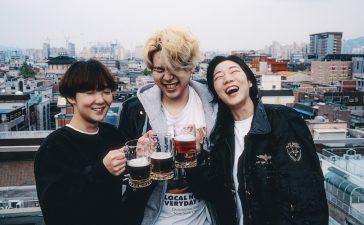It’s tough to imagine anything about Morocco without using the lens of romance and magic – even those who haven’t been there know that the land is steeped in it.
After all, it’s one of the more filmed and photographed countries on Earth; a place where the ancient meets the future. You’ll find the Al-Karaouine University that dates back to 859 CE, but you’ll also find more mobile phones than humans, with almost 47 million smartphone devices for 40 million people who live there.
One result of this duality is a hive of cultural diversity, with religious fundamentalists existing alongside denim-clad punks, and as we learn in the fantastic new documentary Dima Punk, often there is little unity to be found as the country’s hardline population rejects the counter culture.
Dima Punk follows the footsteps of Stof, the self-styled “last punk in Morocco” as he navigates, both literally and physically, the complexities of looking and thinking differently in a place where difference is not celebrated. The film is a fantastic and gripping dissection of character and identity cast to the backdrop of a world that seemingly has no time for either. Dima Punk received a Special Jury Mention from The Hague’s MENA Film Festival, who offered the extrapolation of the character of Stof as “a young Moroccan, resembling a film character, fictional and a little provocative and frivolous, who fights, with only his identity as a weapon, to feel free and accepted.”
Blunt Magazine is thrilled to publish this Special Edition Punk Guide featuring the engimatic Stof, and wonderfully translated by Dima Punk writer and director, Dominique Caubet. Over to you, Stof.
How did you become a punk?
I had a friend who was a hip hop dancer – he was two years older than myself – and he chose to become a punk…I liked it and I asked him a lot about punk and he explained [it] to me. This is how I became a punk when I was 13. He is present in the film Dima Punk, his name is Orland.
Growing up as a young punk in your hometown, what are some of the places you would hang out? For example, in Sydney we would gather at the steps outside our Central Train Station, day and night!
I grew up as a young punk in the popular neighbourhood of Sbata in Casablanca, but we used to meet in the centre of the town in Park Yasmina – which you can see in the film Dima Punk. I also travelled to the capital Rabat, where there were many more punks and they met in an empty house.
How would you describe your typical punk from your hometown?
There are no punks left nowadays in Morocco or in Casablanca. Around 2010, you used to have nice looks and a few mohawks…You have to realise that it is extremely difficult to raise your mohawk in Morocco!! During the festival L’Boulevard, once a year(!!!), you saw some punk looks. But the last edition was September 2019 because of the pandemic.
How does the general community in your hometown take to punks, and punk music?
The Moroccan society never really accepted punks or punk music at all really. When I was younger I got insulted, they called me a “rooster”, a “Satanist” or “not a man”…
What do you think is the biggest threat to the punk community in your city?
From my point of view, the biggest threat for me, as a punk, is to go on living here!!! Anyways, there were very few punk gigs in Morocco…
All over the world, politics and punk go hand in hand. In Australia, many punks talk about climate change and gender equality. What are some of the political issues that influence punks in your hometown?
In Morocco, there are very few militants for any cause, because people are afraid. I’m dreaming of revolution.
Are there any other locations in the city that are important to its punk community? Tattoo studios, for example, or clothing stores, bars and underground clubs?
From 2008 to 2010, punks used to meet in the old centre of the town, Park Yasmina or in Rabat – the capital – where punks used to come from all over the country and meet in an abandoned house. There is also the centre for alternative music, L’Boultek, created by the Festival L’Boulevard (where many scenes of the film were filmed) where, before the pandemic, there were a few concerts…
But nowadays, there are no punks left in Casa or in Morocco.
Who were some great punks, or punk bands making moves from your hometown we can check out?
Historically there were very few punk groups in Morocco. The first punk group came from Rabat. They started around 2005. Their name is Z.W.M, “Zlak Walla Moot”, a literal translation of “Skate or Die” in Moroccan Arabic. They live in France now. There was also a group from Meknes, BLAST (around 2014). The singer also lives in France now…
The only punk group in Casa is my group, which we started in 2020! We named it Dima Punk (‘Forever Punk’). We have problems finding a place for rehearsals and we were able to record only one title. I am the vocalist and I write the lyrics. The title is called ‘Come back tomorrow! – what you get told each time you ask for something…
What are your tips for any punks travelling through your hometown?
Unfortunately, it would be very difficult to meet with any punks nowadays. After the pandemic, they might visit bars like La Cigale, or the Vertigo…Or L’Boultek, if they reopen. I’m talking about a few years ago. And don’t be too trustful. I’m in a pessimistic mood…






